As an Amazon Associate I earn from qualifying purchases.
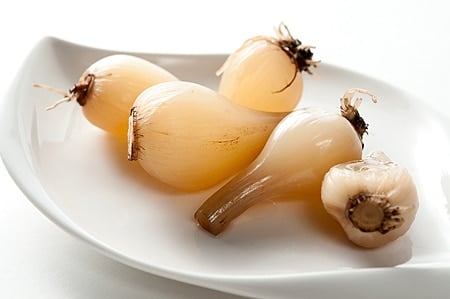
I’d been searching for blue camas for several years because it has a reputation as a world class food. When I finally found some near Truckee last week, I was excited to put these bulbs to the test in my kitchen.
Going into this process, I knew a few key things about eating and cooking with blue camas, camassia quamash: First, they are nasty when eaten raw. They are crunchy enough, but when you chew on them the bulbs get gummy and stick to your teeth. There’s also a soapy taste in there, too. Not good eats.
I also knew that camas is loaded with inulin. Yes, inulin. Long-time readers of this space may remember I’ve had run-ins with this indigestible starch before, with Jerusalem artichokes. Inulin cannot be processed by most humans, so our gut bacteria do the job for us. And those bacteria create gas while performing their duties. Lots of gas. I read stories of pioneers eating undercooked camas bulbs and experiencing the Mighty Wind. Also not good eats.
When in doubt, go to the Indians. Most wild foods in North America were eaten by the Native Americans before us, so reading about what they did with whatever new ingredient you happen to have on hand is a good place to start. Camas is no exception. The various tribes of the American West loved camas, especially the Nez Perce, Shoshone and, to some extent, Paiutes. The smaller California bands did the same in the Sierra.
What did the Indians do with camas? Almost without exception, they baked them, slow and low, in an earth oven. Now I don’t have an earth oven (Yes, it’s true. I feel deprived sometimes… ) but I do have a regular oven. So does fellow forager John Kallas, who wrote about baking his camas bulbs with middling success; he prefers to pressure cook his camas, but I don’t really play around much with a pressure cooker — although I really ought to…
This slow and low cooking breaks the inulin down into fructose, a simple sugar we can all enjoy. How long you cook the camas bulbs governs how sweet they will be. Many Indian groups actually called blue camas “black” camas, not because of anything to do with the plant, but because they baked the bulbs so long the inulin turned to sugar, which then caramelized, darkening the bulbs dramatically. Reportedly, if you take things that far, blue camas bulbs will taste like a combination of a baked pear and a cooked fig. Pretty trippy, eh?
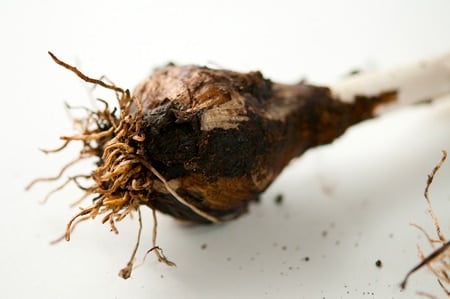
I wasn’t sure I wanted a camas dessert just yet. So I decided to peel the dark, papery sheath around the bulbs, put them in a small casserole dish with a little water and bake them at 220 degrees overnight.
Next morning I took them out and tasted a small one. Now I will be honest: Taking that first bite gave me a little flutter. Why? Because there is also a plant called a death camas, and eating one bulb will make you sick. Eating many can kill you. I was 99 percent sure I’d correctly identified these plants (click for a full identification guide), but there’s always that zephyr of doubt that crosses your mind. I ate the bulb. And it tasted… well, OK. Boring and remarkably like unseasoned mashed potatoes. I added a little salt, and it was much better, but still a little meh.
I put the bulbs back in the oven for 3 more hours. When I took them out again, they’d turned a little golden — sugars beginning to caramelize! I tried another bulb, and this one had a hint of sweetness. It was almost like the sweetness in a parsnip, although it still tasted very much like a root vegetable.
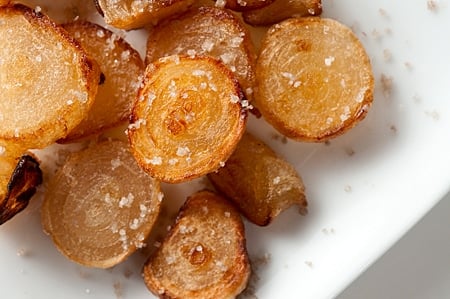
Decision time. Cook longer, or play. I was impatient, so I decided to play. Sure, I could have mashed the bulbs up and served them like potatoes or colcannon or something, but I wanted to highlight them, simply. So I salted them and fried them in a little olive oil, then tossed them with a little homemade verjus (more on that later) and dusted them with smoked salt.
Booyah! Oh so good! Better than the best fried potatoes, with a hint of acidity from the verjus and a hint of smokiness from the smoked salt. Holly and I could not stop eating them. If you ever dig your own camas bulbs, this should be the first recipe you make with them. After that, the sky’s the limit!
Twice Cooked Blue Camas Bulbs
Ingredients
- 1/2 pound blue camas bulbs, about a dozen
- 1 tablespoon olive oil
- 1 tablespoon verjus, lemon juice or white wine vinegar
- Smoked salt
Instructions
- Remove the papery sheath off the bulbs and put them in an ovenproof container with a lid. Pour in just enough water to cover the bottom of the container by about 1/4 inch or so. Cover the container and bake the camas bulbs at 220-230 degrees for 12 hours. Check on them after 8 hours or so. You want them to look anything from pale gold to full golden.
- Slice the bulbs into rings and lightly dust them with fine salt. Saute them in olive oil, butter or some other fat until they brown. They will be a little sticky, so keep the pan moving for the first minute or so to prevent the bulbs from sticking to the pan. Keep an eye on them, as the sugars in the camas will caramelize fast.
- To finish, toss with the verjus and dust with the smoked salt. Eat at once.
Notes
Nutrition information is automatically calculated, so should only be used as an approximation.
MORE ON CAMAS:
- A historical perspective on eating blue camas, from the Old Foodie
- Some USDA information on blue camas
- Another take on blue camas, from This Time, This Space
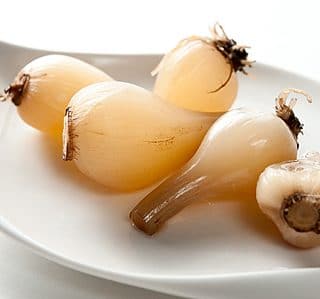
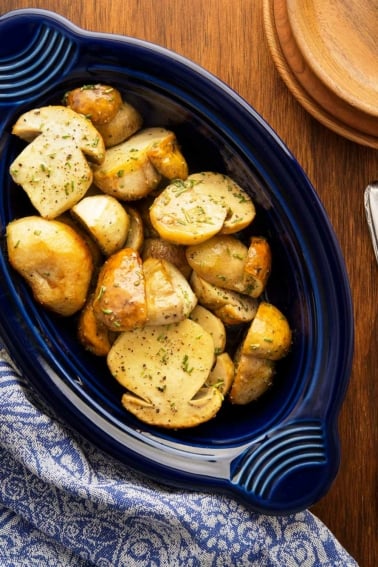
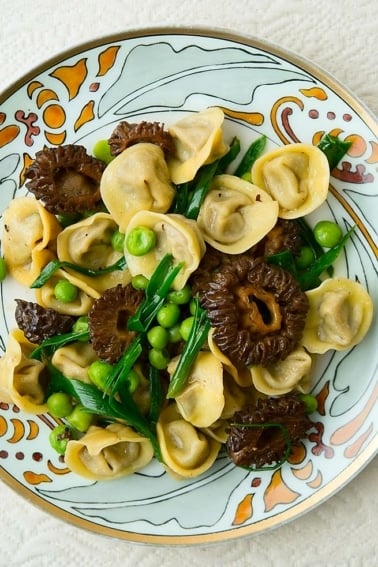
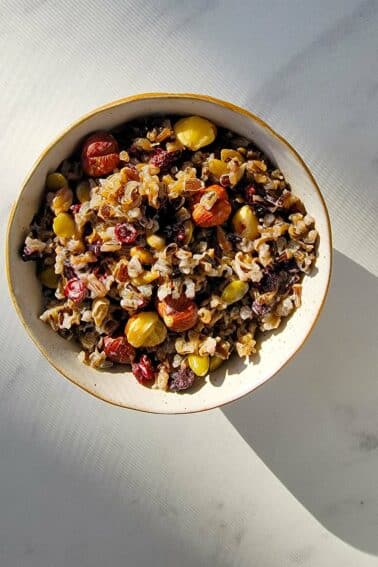
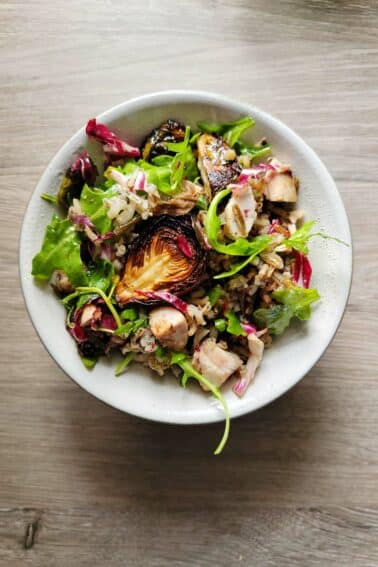
This is a good use for an insulated cook box (mainly used for stews and yogurt) because of the long cook time at low temps. You take a wooden box like an old hope chest, insulate it with foil and old wool blankets with a staple gun. Do the lid well since heat rises and you are trapping it. Bring the bulbs to 270 F or so in a casserole dish with lid in oven or ceramic turkey pan. Remove, quickly wrap in a towel and transfer to the box. You may need to pop back in the oven to bring back up to temp. once during the “bake.” Keep notes so you have a recipe to follow to get them cooked how you want them next time without the guesswork.
I’m in Maryland and have long been interested in the corp of discovery. Read about Camus roots. Can these be purchased?
Thank you
I have been baking my camas for about 9 hours so far…..they just seem to be drying out not really baking…..maybe I don’t have enough water in ther baking dish?
Mel: Yep, that’s it. And they need to be tightly sealed to keep in moisture.
Something to consider: Why are you using the past tense to write about Indigenous peoples? They are still here, and still eat their traditional foods.
Ivriniel: Fair point.
My sisters & I are going to try this today. Thanks for including the identification info. Hopefully we get it right and will be reporting on our success.
Hey Hank,
I know this is an old post but I just thought I’d let you know that not all true edible Camas is blue. Here in the Umpqua valley of southwestern Oregon we have blue Camas, white death Camas, and true edible Camas that is white. Your rule of Camas always being blue holds true, as far as I know, everywhere but here. One theory is that the word Umpqua actually translates as “white camas”.
Jared: Really? Huh. Good to know. I’d be leery of a white camas, though.
As to making wine from Camas bulbs I have no personel experience but came across the Lewis and Clark acount which documents an incident of accidently making beer from some dried camas which had gotten soaked. “enjoyed by all” states the account. Here is a link. https://franceshunter.wordpress.com/2011/07/26/nearly-all-the-men-sick-lewis-and-clark-meet-the-camas-root/
Are your temperatures in centigrade or fahrenheit?
Alan: Always Fahrenheit. I am an American. 😉
I have heard a very long and low cooking for Jerusalem artichokes also has the same effect on the inulin in them. I think the blue camas sadly do not grow where I live (doesn’t get cold enough) and I don’t travel much to where they do grow but I plan to try cooking Jerusalem artichokes the way camas can be cooked and maybe I will try this recipe with them. I need to get some first though. Right now no one in my area is selling them so I probably will have to grow them. your recipe sounds fabulous!
The Coast Salish people of Washington State and British Columbia placed a high value on camas. They were a valued trade item and communities maintained acres of camas fields around their villages. They burned off competing plants and cleared fields to create the most ideal camas growing conditions. The camas were cooked/steamed over 3 to 4 days. An oven was prepared by lining a pit with stones. A fire was lit to heat the stones to scorching hot temps. The stones were then lined with evergreen boughs, the camas layered on top of that. The whole thing was covered in more boughs and skins. Water was poured through a small hole in the top and the camas were left to steam for days. The cooked bulb was pulverized into a smooth white paste which could be eaten fresh or sun-dried to preserve it for winter use. Early settlers record that the paste was sweet. Captain George Vancouver records seeing graves with boxes of camas paste among the goods left for the dead. Entire coastal islands were used for the cultivation of camas and it still grows wild in great abundance in areas of southern Vancouver Island and the Gulf Islands. I have always wanted to try cooked camas. Thanks for your post, it is most interesting!
Kent: Wow, I have no idea. But if I had to guess, the answer would be no. I just don’t think there will be enough sugar in the cooked down camas to make a wine. But I could be wrong…
Can the camas bulb be cooked down to get the sugars and then be made in to wine.
Would cooking camas work in a crock pot on low?
Tamar: The pressure cooking thing most definitely does work. John Kallas does 9 hours at 257 degrees. I’d take them out after that and then slice and fry.
Mojourner: I’ll get on it. Now I just need to find me some basalt…
Ken: Yep, I heard about that method of cooking. Seems pretty involved to me.
Hank, I recently heard how to cook these from a Salish man in northern Montana. They’re buried in a pit with layers of plants and cooked for three days. Didn’t sound hard, just a long process. And apparently they come out as one soild black cake. I think Lewis and Clark have a lot to say about them too.
I REALLY love your blog. It is well written (achievement enough, blog-wise) and informative. I have linked to it previously, I hope you don’t mind. I am all native plants, all the time, but right now it’s just the planting. I haven’t gotten to the food-sourcing part yet; but I have some Salal berries I’ve got my eye on. Good, good stuff. Thank you! I’ll be back! ~Calvin
Just stumbled across your website and boy oh boy am I glad I did. Along with raising beef, chickens and sheep my husband is an avid hunter and angler.
I know my way around venison pretty well but wild turkey has been a challenge for me. So far about the only edible way I have been cooking it is as turkey nuggets. They’re good but I’m ready to move on to other ways of preparing it.
No earth oven? You need one. Go get some vesicular basalt, good hard fire wood, and dig yourself a hole.
One aspect of underground cooking is that you are steaming as much as baking. In Hawai`i and the NW, the only places I’ve experienced this cooking, you heat the rocks, make sure whatever you are cooking is insulated from direct contact (which will brun them to a crisp), and make sure there is sufficient moisture to steam them. Cooking time s similar t what you said for the oven.
As good as those look — and they most certainly do look good — I’d have a hard time justifying keeping an oven going for 12 hours for ’em. Out here in the sticks we pay an exorbitant amount for propane.
Do you suppose the pressure cooker thing would work? The problem is that you’d have to cook the camas in liquid, and the dry heat may be necessary for the flavor you’re talking about. But if you did something like a pressurized pre-cook, and then roasted and fried …
This looks really good. Thanks for sharing